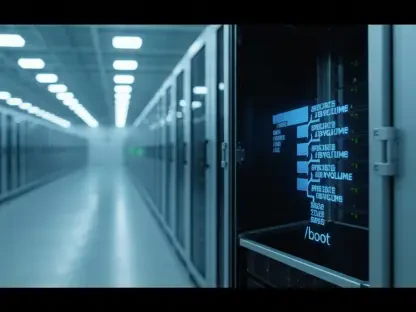In fiscal year 2025, the U.S. government allocated a staggering $27.5 billion towards cybersecurity measures across all federal agencies. Despite this significant expenditure, only a minor portion has been earmarked for the procurement of advanced cybersecurity technology. A majority of the funds are funneled towards labor costs associated with maintaining cybersecurity systems, a fact that highlights a potential inefficiency in resource allocation. While reports indicate a higher emphasis on manpower, private sectors maintain a more balanced spending ratio. This disproportionate allocation raises questions about the effectiveness of federal cybersecurity investments and the need for a strategic rethink.
Efforts to enhance federal cybersecurity should focus not just on increasing budgets but also on optimizing expenditure to ensure effective protection against cyber threats. Current spending trends show a glaring disparity: a bulk going towards hiring and maintaining service personnel rather than equipping these professionals with cutting-edge technological tools. The emphasis should be on achieving a harmonious balance between manpower and technology, with a renewed focus on refining operational procedures to ensure maximum security.
1. Substitute Compliance Assessment
The federal government’s approach, historically rooted in compliance-driven initiatives, requires a fundamental shift towards assessing real and tangible cybersecurity outcomes. The existing system, anchored in compliance with protocols such as the Federal Information System Management Act, while foundational, places undue emphasis on procedural adherence rather than practical effectiveness. Agencies primarily concentrate their efforts on meeting these compliance standards without necessarily considering their direct impact on improving security measures.
Introducing selective performance indicators to evaluate agencies’ cybersecurity robustness can significantly reshape this landscape. By emphasizing metrics like the mean time to detect and respond to breaches (MTTD and MTTR), agencies can better gauge their cybersecurity resilience. These metrics can offer insights not only into the speed with which breaches are identified and neutralized but also into the overall cybersecurity health of an agency. The current scenario calls for moving beyond checklist-oriented audits to focus on actionable data-driven insights that directly contribute to enhancing an agency’s cybersecurity posture.
In implementing these changes, the Office of Management and Budget (OMB) along with the Cybersecurity and Infrastructure Security Agency (CISA), should play a pivotal role in defining and enforcing these new performance measures. By ensuring uniform application across all federal agencies, these performance indicators can help shift the focus from a compliance-centric model to an outcome-oriented framework. This transformative step would not only streamline cybersecurity efforts but also ensure that resources are directed towards bolstering cybersecurity resilience rather than merely ticking audit boxes.
2. Minimize Cybersecurity Tools
Federal agencies often grapple with a fragmented cybersecurity infrastructure, primarily due to an over-reliance on multiple point solutions addressing specific system vulnerabilities. This complexity, a byproduct of the compliance-driven approach, results in an unnecessarily convoluted cybersecurity environment. Many agencies have accumulated a myriad of tools from different vendors, resulting in operational inefficiencies and increased costs. The current landscape calls for a reduction in the number of cybersecurity tools by transitioning to more integrated and modern platforms.
By minimizing reliance on individual point solutions, agencies can adopt comprehensive cybersecurity platforms that offer an array of integrated functionalities. This shift towards modern platforms allows for a unified response to threats and simplifies operational processes. Such platforms can cater to multiple systems within an agency, reducing redundancy and improving overall security efficiency. The rationalization of tools is not only cost-effective but also enhances enterprise-wide visibility, leading to more coordinated and effective threat neutralization efforts.
Moreover, the cybersecurity product industry has seen rapid technological advances, with modern platforms offering more robust and scalable solutions. Agencies should leverage these developments to create streamlined cybersecurity environments that enhance both operational and financial efficiencies. This approach not only optimizes resource allocation but also fosters a proactive cybersecurity stance, anticipating and neutralizing potential threats with greater efficacy. The emphasis must be on evolving towards cohesive, enterprise-level security solutions that address agency-wide vulnerabilities, thereby reinforcing the overall security framework.
3. Integrate AI Solutions
Artificial intelligence is emerging as a formidable tool in optimizing cybersecurity operations, providing automation and orchestration capabilities that significantly reduce manual intervention. The integration of AI tools into Security Operations Centers can revolutionize current practices by enhancing threat detection, analysis, and response times. Federal agencies, known for their complex and labor-intensive security operations, stand to benefit immensely from the deployment of AI-based solutions to streamline processes and reduce operational costs.
AI-centric tools harness machine learning to better understand and predict cyber threats, thereby offering a strategic advantage in combating potential breaches. These tools, by integrating threat intelligence and analytics, can autonomously process vast amounts of data to pinpoint suspicious activity with precision. This high level of automation reduces the reliance on human analysts, potentially lowering costs while increasing operational efficiency. The implementation of these AI-driven solutions ensures that agencies are equipped with the latest technology to rapidly detect and respond to breaches.
Furthermore, modern AI solutions can provide a holistic view of the cybersecurity landscape, offering improved enterprise visibility and facilitating more effective decision-making. Adopting such advanced technologies not only fortifies defense mechanisms but also aligns with the broader government mandate of streamlining operations and achieving cost efficiencies. The integration of AI into cybersecurity operations is not just a progressive step but a necessary evolution in fortifying agencies against sophisticated cyber threats while minimizing operational expenditure.
4. Revise Procurement Procedure
The current federal procurement protocols pose significant challenges to the swift deployment of necessary cybersecurity technologies, often hindering timely responses to emerging threats. Treating cybersecurity as a national security imperative necessitates a reevaluation and reform of the procurement processes to allow rapid adoption of cutting-edge technologies. The existing bureaucratic procurement cycles are outpaced by the rapidly evolving cyber threat landscape, underscoring the need for more agile and responsive acquisition strategies.
Federal agencies need enhanced discretion and flexibility in licensing and deploying the latest cybersecurity solutions efficiently. This can be achieved by reengineering procurement practices to align more closely with technological advancements and the urgent need for improved security measures. Streamlined procurement processes can ensure that agencies have the capabilities to combat threats effectively, neutralizing adversaries’ advantages gained through slower bureaucratic procedures.
Reforming procurement is not about bypassing due diligence; rather, it is about instilling a sense of urgency proportional to the threats faced. This entails adopting practices from emergency procurement models, where adaptability and speed are prioritized. Ultimately, rethinking procurement procedures will empower agencies to stay ahead in the cybersecurity race, positioning them strategically to counteract and preempt cyber threats with the latest innovations in technology, ensuring national security is uncompromised.
Strategic Priorities Moving Forward
In the 2025 fiscal year, the U.S. government dedicated a substantial $27.5 billion to cybersecurity for all federal agencies. Despite this large allocation, only a small fraction is designated for acquiring advanced cybersecurity technology. Most of the budget is funneled towards labor costs to maintain current cybersecurity systems, which reflects a possible inefficiency in resource use. Reports indicate a stronger focus on manpower, unlike private sectors that display a more balanced investment between workforce and technology. This imbalance questions the effectiveness of federal cybersecurity funding and calls for a strategic reassessment.
Improving federal cybersecurity shouldn’t just be about increasing the budget but also about optimizing how these funds are used for effective cyber threat defense. The present spending tendencies reveal an evident disparity, with the larger portion going towards hiring and retaining staff rather than providing them with state-of-the-art technological tools. The focus should instead be on balancing manpower with technology and refining operational processes to ensure security is maximized.









